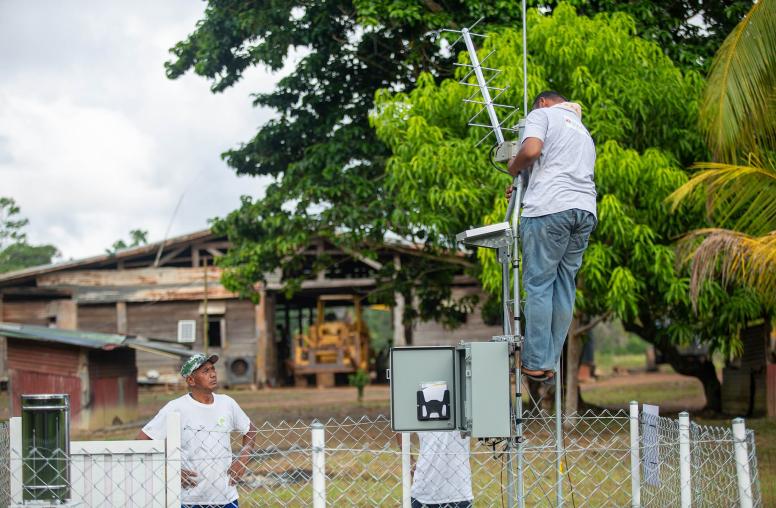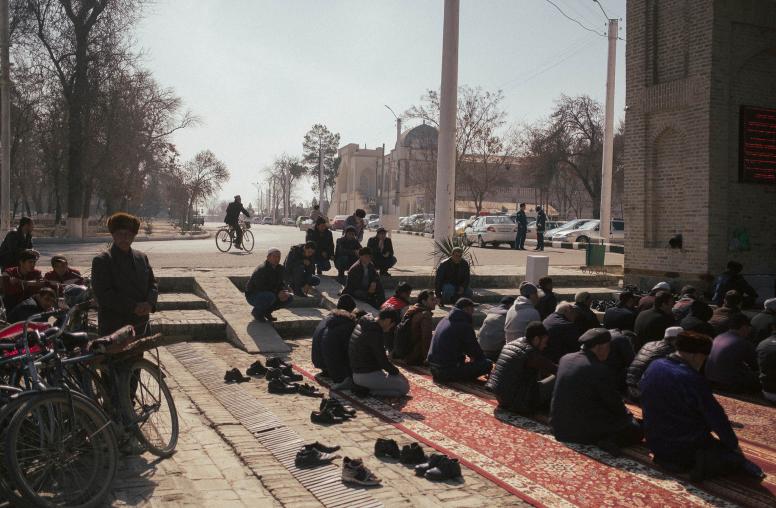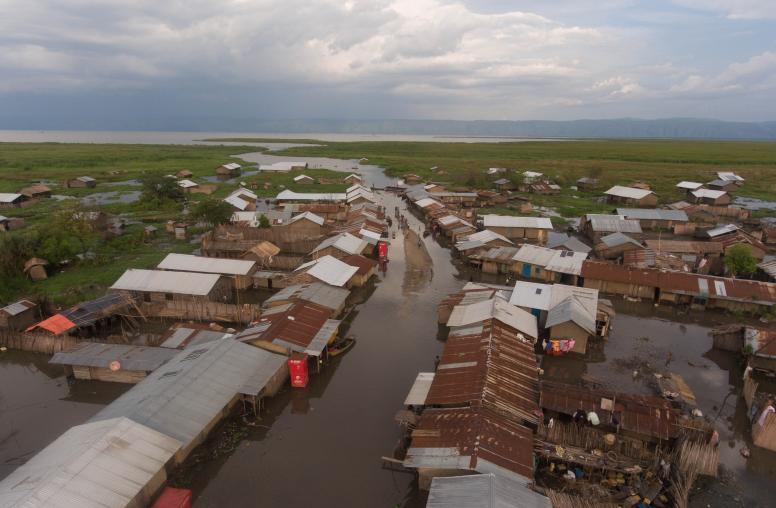Ending Sexual and Gender-Based Violence in War and Peace
Recommendations for the Next U.S. Administration
Sexual and gender-based violence (SGBV) can undermine long-term state stability and security even after states have transitioned out of violent conflict. This brief highlights four areas around SGBV that require urgent attention: the conflict cycle, moving beyond armed actors, protectors as perpetrators, and the role of SGBV in threatening political participation. This Brief was prepared by several members of the Missing Peace Young Scholars Network, supported through a longtime partnership between United States Institute of Peace (USIP); Human Rights Center, UC–Berkeley Law; Peace Research Institute Oslo (PRIO); and Women In International Security (WIIS). The Missing Peace Young Scholars propose a series of policy recommendations, keeping in mind the importance of ongoing collaboration as key to prevention and relief efforts.
Summary
- Sexual and gender-based violence (SGBV) often does not stop when the war ends, and therefore continues to undermine long-term security and stability.
- Perpetrators of SGBV are not limited to armed actors but also include government security officials, United Nations Peacekeepers, and civilians.
- SGBV is more likely when individuals are socialized to devalue women and girls, which underscores a need for more gender-transformative programming.
- Governments should recognize that SGBV might be used to suppress political and civic participation of marginalized groups—including but not limited to women—who vote, protest, campaign, or mobilize within civil society.
- Both collaboration among policymakers, researchers, and practitioners and research in areas such as postconflict reconstruction, disaster relief, refugee assistance, and peacekeeping are needed to improve policy responses to address SGBV.
Introduction
Addressing sexual and gender-based violence (SGBV) is paramount to security. Around the globe, violent extremist actors—from ISIL to lone gunmen—have committed atrocities against women. Societies or individuals with a history of SGBV, thus, serve as an indication of the potential for more widespread or continued violence. To ensure security for all, it is important to devote resources toward ending SGBV.
Over the past fifteen years, there has been growing attention to wartime SGBV as a broader part of the women, peace, and security agenda, signified by nine UN Security Council Resolutions. There have also been increasing attempts to prosecute rape as a war crime and crime against humanity at the International Criminal Court. The new U.S. administration entering office in January 2017 should build on this momentum and expand efforts to protect women and girls, men and boys from SGBV globally and at home.
This brief highlights four areas around SGBV that require urgent attention: the conflict cycle, moving beyond armed actors, protectors as perpetrators, and the role of SGBV in threatening political participation. Research that helps clarify its enabling factors and implications is of utmost importance for U.S. policymakers and their international partners. The Missing Peace Young Scholars—experts in fields such as public health, political science, and law—propose the following policy recommendations, keeping in mind the importance of ongoing collaboration as key to prevention and relief efforts.
Conflict Cycles
SGBV can undermine long-term state stability and security even after states have transitioned out of violent conflict. The term “postconflict” is relative in places where women and girls continue to experience acute security concerns, both at home and in their communities. The home may actually be one of the most unsafe places for women, particularly for survivors of sexual violence, as SGBV has become normalized during conflict.1 In turn, male partners use violence to reassert their power and control.2 Moreover, evidence suggests that in areas generally affected by acute levels of violence—be it related to armed conflict or criminal networks—levels of SGBV are also higher. Across neighborhoods in Rio de Janeiro, Brazil, for example, high levels of urban violence are correlated with high levels of sexual violence.3
Even if sexual violence is not directly used as a practice of war, it still may be prevalent in conflict situations. For example, during the Lord’s Resistance Army insurgency in northern Uganda, girls as young as seven were forced into prostitution by family members, or engaged in sex work as an economic necessity to survive.4 Because policymakers consider forced prostitution a domestic issue, interventions have largely ignored forced prostitution as a form of SGBV perpetrated during war, even though the majority of the violence perpetrated against these girls—sexual or otherwise—was reported to have been from Ugandan soldiers. But absent the conflict, it is unlikely that these girls would have been forced into prostitution. Forced prostitution during and after the conflict has contributed to the development of human trafficking networks internally in Uganda and across the East African region.
A narrow emphasis on conflict-related rape can overshadow ongoing SGBV that continues long after peace treaties have been signed. Conflict leaves in its wake broad social disruptions, including economic devastation and social disturbances that affect postconflict stability and contribute to high rates of conflict recurrence.
Policy Recommendations: We encourage the new administration to (1) sponsor a UN Security Council Resolution that focuses on the link between insecurity and instability caused by armed conflict and acute emergencies, and ongoing violence in postconflict settings; and (2) allow survivors of nonconflict-related SGBV access to services earmarked for survivors of conflict-related SGBV. Doing so recognizes that SGBV may be caused by the multiple pathways through which armed conflict influences and normalizes SGBV.
Moving Beyond Armed Actors
Perpetrators of SGBV are commonly thought to be armed combatants. They are often thought of as undisciplined rebels, insurgents, and government militants, who have little training and oversight. While many perpetrators of sexual violence have or take on these characteristics, moving beyond conventional ideas of who perpetrators are is important for future prevention efforts.5
New scholarship suggests that even in acutely conflict-affected areas, civilians may be the most common perpetrators of human rights abuses, including sexual violence. Perpetrators include “regular people,” such as teachers, employers, and motorbike drivers, who engage in such behavior both during and outside of conflict. In a population-based survey of human rights abuses in eastern Democratic Republic of the Congo mining towns, women reported that the most common perpetrators of rape and forced marriage were civilians, including mining bosses, neighbors, and family members.6 Armed actors were among the least-cited perpetrators of sexual violence in these areas. Research from postconflict Liberia finds that many perpetrators are minors; and where a transitory lifestyle is common (characterized by high migration and low rates of land ownership), perpetrators are often neighbors.7 Understanding the profile of perpetrators will bolster future prevention efforts.
Conceptualizing perpetrators as only armed actors has encouraged donors to focus on legal accountability via prosecuting sexual violence—either as war crimes or crimes against humanity—in courts such as the International Criminal Court or the ad hoc tribunals for Rwanda and the former Yugoslavia. In the long term, however, an international prosecution-based strategy alone is not enough to combat SGBV, as it will not change the prevailing societal norms that contribute to making everyday citizens (and armed combatants) perpetrate SGBV. For incidents of SGBV to decline, a domestic prosecution strategy that addresses conflict- and nonconflict-related SGBV must be coupled with prevention efforts that emphasize gender-transformative programming.8
Policy Recommendations: We encourage the new administration to (1) fund prevention programming that recognizes both combatants and noncombatants as potential perpetrators who may confront a host of enabling factors contributing to the perpetration of SGBV, such as alcoholism, unemployment, unstable living situations, and fragmented community ties; and (2) continue prosecution-based strategies while also funding data-driven prevention efforts that seek to transform prevailing societal/gender norms that enable or encourage SGBV.
Protectors As Perpetrators
In addition to armed combatants and civilians perpetrating SGBV, government soldiers and police officers—who are supposed to protect citizens from SGBV—also engage in such violence. Militaries and police may engage in a campaign of SGBV with the aim of obtaining information through torture or as a means of extortion.9 There have also been documented uses of SGBV to suppress dissident groups in Kenya, as well as the use of rape as a form of compensation to the combatants and allied militias affiliated with the government in South Sudan, which has been unable to pay troops in the face of a collapsing economy.10 Finally, military personnel may perpetrate SGBV within their own ranks, as has been documented within branches of the U.S. armed services.
United Nations Peacekeepers also perpetrate SGBV. According to the United Nations Conduct and Discipline Unit, there were sixty-nine incidents of sexual exploitation and abuse in 2015, though the numbers are likely much higher due to underreporting. Research shows that peacekeepers who come from countries with records of low gender equality are more likely to perpetrate sexual exploitation and abuse,11 as well as other human rights violations, in the mission host country.12 These studies indicate that the composition of peacekeeping forces influences the quality of missions: when peacekeepers are socialized to devalue women in their home countries, abuses abroad are more likely.
Policy Recommendations: We encourage the new administration to (1) improve civilian oversight and accountability over the military of friendly states, particularly states that are receiving technical or financial support from the administration; (2) prioritize legislative action on sexual assault within the U.S. military and Department of Defense that builds on the progress made by the Obama administration’s executive actions to expand victims’ rights within the military justice system, improve command accountability, and increase training; and (3) follow the recommendations from the “High-level Independent Panel on Peace Operations” and the “High-level Review on Women, Peace and Security: 15 Years of Security Council Resolution 1325,” which includes recommendations for preventing peacekeeping abuses.
Gender Inequality, Including SGBV, Threatens Women’s Political Participation
SGBV contributes to perpetuating gender inequalities. It has significant political and social ramifications, including the potential to suppress individuals who attempt to reform gender-inequitable systems. SGBV is a major risk to individuals, particularly women, who engage in democratic processes such as voting, civil society activism, and running for office, posing a challenge to agencies charged with implementing UN Security Council Resolution 1325 and women’s empowerment programs. Women activists, voters, and party supporters are at grave risk of SGBV, as evidenced by rapes of women who engaged in public demonstrations in post-Mubarak Egypt, and by rape and sexual torture that occurred as part of election-related violence in Kenya and Zimbabwe.13 Direct experiences with SGBV may shape women’s political identities in ways that can be used in the ideological frameworks of extremist movements and insurgent groups.14
SGBV and other forms of violence against women in politics does not happen only in places experiencing political turmoil; it occurs even in stable democracies. Even with concerted efforts to boost women’s participation, women are underrepresented in many national parliaments, security sectors, and peace processes. This exclusion limits their ability to shape policies related to SGBV, including survivor-centric programming, and stifles their political power.
Policy Recommendations: We encourage the new administration to address the intersection of SGBV and political participation by (1) continuing to support and expand efforts that tackle systemic gender inequality, sexual violence, and the marginalization of women from political processes by providing sufficient staffing and resource support for the State Department’s Office of Global Women’s Issues; and (2) encouraging U.S. agencies that implement democracy promotion activities, including international election observation, to integrate training on SGBV as part of overall efforts to make democracy promotion programs more gender-sensitive.
Conclusion
Important steps moving forward include recognizing that: SGBV does not begin or end with war; perpetrators of SGBV are a diverse group and perpetrate SGBV for a variety of reasons; when communities and individuals are socialized to devalue women and girls, SGBV is more likely; and there is an association between SGBV and political participation.
The incoming administration will need innovative approaches to tackle SGBV, but these new policy avenues are not possible without rigorous research. Recent findings make important distinctions and identify contradictions and nuances previously unexplored. The sensitive nature of SGBV demands meticulous, ethically conducted research and the financial and institutional support to make such research possible. Open dialogue between researchers and decision makers ensures that both policy and research initiatives are based on the most up-to-date information regarding the influence of SGBV and gender inequality on daily life and during crises. Thus, we urge funding for continued research and collaboration among academics, practitioners, and policymakers to continue to uncover important areas for policy development and reform.
Notes
- Jocelyn Kelly and Michele Decker, “From Political Violence to Domestic Violence: Examining the Impact of Conflict on the Intimate Partner Violence in Sub Saharan Africa” (paper presented at the Population Association of America Conference, San Diego, California, April 30–May 2, 2015).
- Kathryn Falb et al., “Gender Norms, Poverty, and Armed Conflict in Cote D’Ivoire: Engaging Men in Women’s Social and Economic Empowerment Programming,” abstract, Health Education Research 29, no. 6 (December 2014): 1015–27.
- Renata Giannini, P. McNamee, and G. Miranda, “Fragile Cities and Gender Based Violence: The Case of Rio de Janeiro,” in Women, Urbanization and Sustainability: Practices of Survival, Adaptation and Resistance, ed. A. Lacey (Auckland: Palgrave Macmillan, Forthcoming).
- Amanda H. Blair, “Relative (In)visibility: Differentiating Societal from Conflict-Related Rape in Northern Uganda” (working paper, University of Chicago, Forthcoming).
- Dara Kay Cohen, “Explaining Rape During Civil War: Cross-National Evidence (1980–2009),” American Political Science Review 107, no. 3 (2013): 461–477.
- Jocelyn Kelly et al., “Assessment of Human Trafficking in Artisanal Mining Towns in Eastern Democratic Republic of the Cong,” (Washington, DC: U.S. Agency for International Development, 2014).
- Sabrina Karim, “Preventing Rape in Monrovia: Current Prevalence and Patterns” (paper presented at the PRIO Workshop on Armed Conflict, Maternal and Child Health, and the Impact of Development Aid in Sub-Saharan Africa, Oslo, Norway, September 22–23, 2016).
- Promundo and CARE International are among the organizations that educate men and boys about qualities of positive masculinity, such as tolerance, empathy, and support for women’s rights. See for example Promundo’s evidence-based Program H and the “Be a Man” Clubs in the Western Balkans, www.care.org/work/education/youth/be-man.
- Judy Gitau, Oversight and Accountability of a Military Operating at Home: War on terror in Kenya (Nairobi, Kenya: Grey Literature, The Centre for Human Rights and Policy Studies, 2016).
- Alicia Elaine Luedke, “Violence Begets Violence: Justice and Accountability for Sexual and Gender-Based Offences in South Sudan” (London, England: Justice Africa in partnership with Community Empowerment for Progress and South Sudan Women Lawyers Association, 2016).
- Sabrina Karim and Kyle Beardsley, “Explaining Sexual Exploitation and Abuse in Peacekeeping Missions: The Role of Female Peacekeepers and Gender Equality in Contributing Countries,” Journal of Peace Research 53, no. 1 (2016): 100–115.
- Marisella Rodriguez and Brandon Kinne, “Bad Apple or Rotten Tree? Institutional, Societal, and Military Determinants of Peacekeeping Abuses” (working paper, University of California, Davis, 2016)
- Nicole Gerring, “Election Related Sexual Violence: The Cases of Kenya and Zimbabwe” (working paper, Wayne State University, Michigan, 2016).
- Nimmi Gowrinathan, “Inside Camps, Outside Battlefields: Security and Survival for Tamil Women,” St. Antony’s International Review 9, no. 1 (2013): 11–32; Nimmi Gowrinathan and Kate Cronin-Furman, “The Forever Victims?: Tamil Women in Post-War Sri Lanka” (New York, NY: Colin Powell School for Civic and Global Leadership, 2015).
About this Brief
This Brief was prepared by several members of the Missing Peace Young Scholars Network, supported through a longtime partnership between the United States Institute of Peace (USIP); Human Rights Center, UC–Berkeley Law; Peace Research Institute Oslo; and Women In International Security, and led by senior experts Kathleen Kuehnast, Kim Thuy Seelinger, Inger Skjelsbaek, and Chantal de Jonge Oudraat. Formed in 2013, the network comprises researchers from a wide range of academic backgrounds committed to understanding and ending sexual violence in war. Members have met annually at USIP to examine the current state of knowledge and identify paths for future research. Network members Amanda H. Blair, Kerry Crawford, Kathryn Falb, Nicole Gerring, Renata Giannini, Judy Gitau, Nimmi Gowrinathan, Sabrina Karim, Jocelyn Kelly, Alicia Luedke, and Marisella Rodriguez collaborated to write this Peace Brief based on insights from their research on topics related to sexual and gender-based violence.



